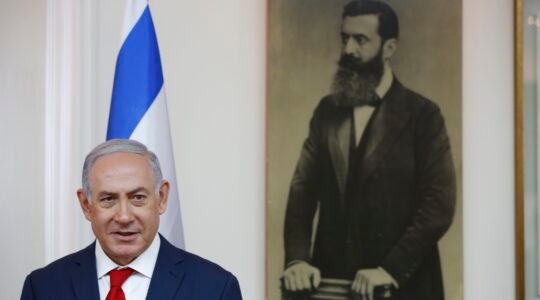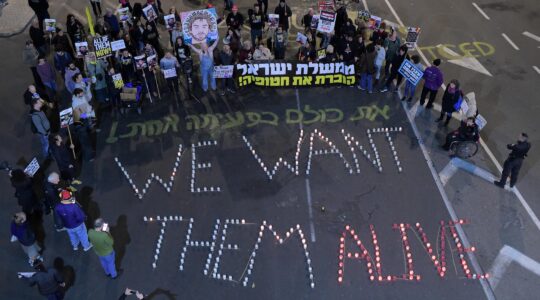(JTA) – Now that Hamas appears to have achieved one of the central goals of its confrontation with Israel, the capture of a live Israeli soldier, a number of things are likely to follow.
Hamas is going to trumpet its operation as a success, and that assertion will reach receptive ears among Palestinians. With thousands of Palestinians locked up in Israeli prisons, the capture of Lt. Hadar Goldin on Friday gives Hamas a chit with which to negotiate with the Israelis.
Polls show that far more Palestinians back the idea of capturing Israeli soldiers to trade for Palestinian prisoners than, say, terrorist attacks against Israeli civilians. By and large, the idea of trading prisoners for prisoners gets broad Palestinian support.
The last time Hamas captured an Israeli soldier, Gilad Shalit in 2006, Israel hemmed and hawed for five years but eventually agreed to the release of more than 1,000 Palestinian prisoners in order to set Shalit free in 2011. At least one of the released prisoners, Ziad Awad, went on to murder an Israeli, Baruch Mizrahi, a police chief killed near Hebron in early April.
Goldin’s capture also gives Hamas an opportunity to demonstrate its supremacy over the Palestinian Authority, bolstering Hamas’ argument that it is able to achieve more through violence than the Palestinian Authority is able to achieve through diplomacy.
In Israel, the public debate over the efficacy of lopsided prisoner exchanges will be renewed, probably with unprecedented intensity.
Critics of the Shalit deal warned that the lopsided trade would encourage more kidnappings, and indeed several kidnapping attempts have taken place since then. The most recent was the abduction in June of three Israeli teenagers from a hitchhiking post in the West Bank. That incident, in which the three boys were murdered shortly after their abduction, helped spark the current round of Israeli-Palestinian violence.
Goldin’s capture highlights the inherent challenge of a policy in which no Israeli, dead or alive, is left behind. Friday’s incident marked the second time during the current fighting that Hamas claimed to have captured an Israeli: On July 20, seven Israeli soldiers were killed when their armored personnel carrier was struck by an anti-tank shell, but only six bodies were recovered. Hamas said it had the seventh soldier, Oron Shaul, in hand, and provided his name as proof, suggesting that Hamas at least might have recovered his dog tags.
On July 25, Israel officially declared Shaul a “a soldier killed in action whose burial site is unknown” — a signal, perhaps, that the Israeli government would take a tough line in any negotiation for his remains.
For Israel, great value is attached to retrieving even the bodies of Israelis. In 2008, Israel traded five Lebanese prisoners and the remains of 199 Lebanese fighters to Hezbollah in exchange for the remains of two Israeli soldiers, Ehud Goldwasser and Eldad Regev, whose bodies were captured in the incident that sparked the 2006 Second Lebanon War. While Goldwasser and Regev officially were not known to have been killed, Israeli intelligence services concluded long before the swap that they almost certainly had died in the 2006 incident along the Lebanon-Israel border.
In 2007, Israel released a Hezbollah member and two Hezbollah bodies in exchange for the remains of an Israeli who drowned in the Mediterranean and washed ashore in Lebanon.
Shalit was Israel’s longest-held captive to return home alive. While successive Israeli governments held out for more than five years under mounting public pressure for a deal, ultimately the Israeli Cabinet voted for a prisoner swap, despite the high price.
It remains to be seen how that experience will influence public thinking now that Goldin has been abducted.
Moshe Yaalon, now Israel’s defense minister, was a staunch critic of the Shalit deal. In 2008, when he was IDF chief of staff, he argued against lopsided swaps in a speech at an IDF conference.
“When it comes to the question of a deal, I am one of those who call for the minimum,” Yaalon told the security conference at Tel-Hai Academic College. “And in some cases we must even say we are ready to sacrifice in the face of what we are required to pay, because the payment price is much heavier than the price of losing the hostage.”
For now, Israeli troops are carrying out intensive operations in the southern Gaza Strip, where Goldin was captured, in an effort to locate and recover him.
JTA has documented Jewish history in real-time for over a century. Keep our journalism strong by joining us in supporting independent, award-winning reporting.






